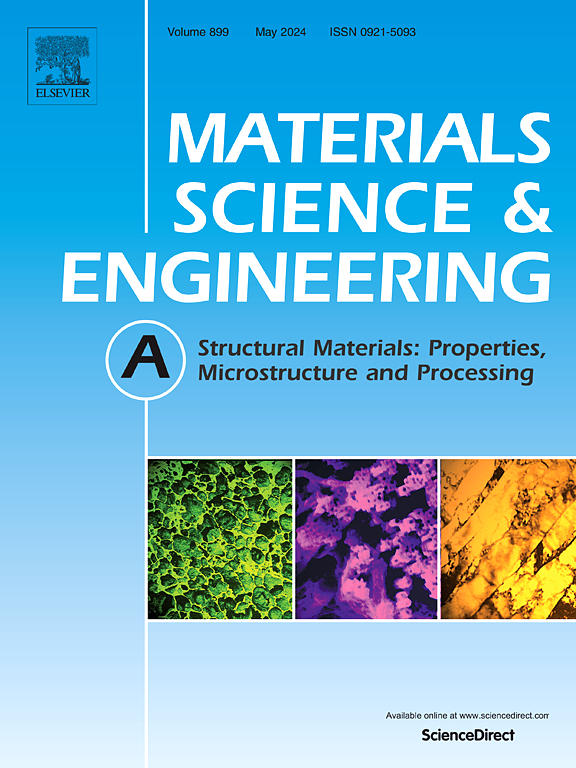电脉冲增强激光增材制造718Plus合金Laves相溶解及拉伸性能
IF 6.1
2区 材料科学
Q1 MATERIALS SCIENCE, MULTIDISCIPLINARY
引用次数: 0
摘要
首次将电脉冲技术应用于镍基高温合金的激光增材制造,研究了电脉冲处理对合金Laves相溶解行为和拉伸性能的影响。结果表明,EPT通过改变体系的自由能,降低了Laves相溶解过程中的热力学势垒,使Laves相在相对较低的温度(1050℃)下溶解。在电流绕行效应下,Laves相优先溶解在曲率半径较小的区域。基于Johnson-Mehl-Avrami-Kolmogorov (JMAK)模型,分析了EPT作用下Laves相的溶解动力学。建立了EPT和常规热处理条件下Laves相溶解动力学的定量关系。理论分析和定量计算表明,EPT在1050℃下的扩散系数比在CHT下的扩散系数高10倍。Laves相体积分数的降低导致伸长率的显著提高。较低的处理温度和较短的处理时间有效地抑制了异常晶粒的生长,使EPT-3样品的伸长率显著提高到39.5%。系统分析了沉积态、EPT-3和CHT-6试样的破坏机制和裂纹萌生。结果表明,应用EPT可以在较低温度下快速获得合金所需的显微组织。与CHT技术相比,EPT技术为LAM镍基高温合金后处理提供了一种清洁、高效、潜力无限的新方法。本文章由计算机程序翻译,如有差异,请以英文原文为准。
Electropulsing-enhanced dissolution of Laves phase and tensile properties in laser additively manufactured 718Plus alloy
Electropulsing technique was first used for laser additive manufacturing (LAM) of Ni-based superalloy, and the effect of electropulsing treatment (EPT) on the dissolution behavior of Laves phase and tensile properties was investigated. The results show that EPT reduces the thermodynamic potential barrier during the Laves phase dissolution process by altering the free energy of the system, enabling the dissolution of Laves phase at a relatively low temperature (1050 °C). Moreover, the Laves phase preferentially dissolves in the region of small curvature radius under the current detour effect. Based on the Johnson–Mehl–Avrami–Kolmogorov (JMAK) model, the dissolution kinetics of Laves phase under EPT was analyzed. The quantitative relationship of Laves phase dissolution kinetics under EPT and conventional heat treatment (CHT) was established. Theoretical analysis and quantitative calculations reveal that the diffusion coefficient of the EPT at 1050 °C is 10 times higher than under CHT. The decrease in Laves phase volume fraction leads to a significant increase in elongation. The lower treatment temperatures and shorter times effectively suppressed abnormal grain growth, resulting in a significant increase in elongation of the EPT-3 sample to 39.5 %. The failure mechanisms and crack initiation of as-deposited, EPT-3 and CHT-6 samples were systematically analyzed. It can be found that the required microstructure of the alloy can be rapidly achieved at lower temperatures by applying EPT. Compared with CHT, the EPT technology provides a clean, efficient, and limitless potential new post-treatment method for LAM Ni-based superalloys.
求助全文
通过发布文献求助,成功后即可免费获取论文全文。
去求助
来源期刊

Materials Science and Engineering: A
工程技术-材料科学:综合
CiteScore
11.50
自引率
15.60%
发文量
1811
审稿时长
31 days
期刊介绍:
Materials Science and Engineering A provides an international medium for the publication of theoretical and experimental studies related to the load-bearing capacity of materials as influenced by their basic properties, processing history, microstructure and operating environment. Appropriate submissions to Materials Science and Engineering A should include scientific and/or engineering factors which affect the microstructure - strength relationships of materials and report the changes to mechanical behavior.
 求助内容:
求助内容: 应助结果提醒方式:
应助结果提醒方式:


